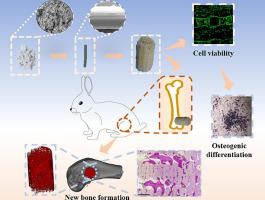当前位置:
X-MOL 学术
›
Mater. Des.
›
论文详情
Our official English website, www.x-mol.net, welcomes your feedback! (Note: you will need to create a separate account there.)
3D printed Nanohydroxyapatite/Polyamide 66 scaffolds with balanced mechanical property and osteogenic ability for bone repair
Materials & Design ( IF 8.4 ) Pub Date : 2024-04-01 , DOI: 10.1016/j.matdes.2024.112896 Zhimou Zeng , Ping Song , Xingyu Gui , Boqing Zhang , Li Zhao , Pin Feng , Zhipeng Deng , Linnan Wang , Wei Wei , Chen Fan , Yunhong Wu , Qingquan Kong , Yujiang Fan , Changchun Zhou , Yueming Song
Materials & Design ( IF 8.4 ) Pub Date : 2024-04-01 , DOI: 10.1016/j.matdes.2024.112896 Zhimou Zeng , Ping Song , Xingyu Gui , Boqing Zhang , Li Zhao , Pin Feng , Zhipeng Deng , Linnan Wang , Wei Wei , Chen Fan , Yunhong Wu , Qingquan Kong , Yujiang Fan , Changchun Zhou , Yueming Song

|
The biomaterial requirements for bone tissue repair are extremely strict. It not only requires the biomaterial to have good biocompatibility and biological activity, but also requires sufficient mechanical strength. Polyamide 66 (PA66) and nano-hydroxyapatite (n-HA) have been widely investigated in bone tissue engineering scaffold, however, its composites require further research. In this study, the 3D printing technology was utilized to fabricate personalized n-HA/PA66 bone tissue scaffold. The mechanical properties of n-HA/PA66 composite can be adjusted by configuring different raw material components and applying different porosity. It was found that 50 % porosity n-HA/PA66 composite scaffold showed a uniform porous structure and a compressive strength of 33.9 MPa. The composite scaffold also exhibited excellent biological properties while improving mechanical properties, in vitro cell tests indicated that the 3D printed n-HA/PA66 composite scaffold promoted differentiation of bone marrow mesenchymal stem cells (BMSCs) into osteoblasts. In in vivo animal model proved that the scaffold promoted endogenous bone regeneration in rabbit patellar bone defects, with newly formed bone volume of 20.9 % after two months of implantation. This research proposed a 3D printed polyamide/nano-hydroxyapatite composite with balanced mechanical property and osteogenic ability for customized bone tissue repair, and it has promising application prospects.
中文翻译:

3D打印纳米羟基磷灰石/聚酰胺66支架具有平衡的机械性能和成骨能力,用于骨修复
骨组织修复对生物材料的要求极其严格。它不仅要求生物材料具有良好的生物相容性和生物活性,还要求有足够的机械强度。聚酰胺66(PA66)和纳米羟基磷灰石(n-HA)在骨组织工程支架中已被广泛研究,但其复合材料还需要进一步研究。本研究利用3D打印技术制造个性化的n-HA/PA66骨组织支架。 n-HA/PA66复合材料的机械性能可以通过配置不同的原材料组分和应用不同的孔隙率来调节。结果发现,孔隙率50%的n-HA/PA66复合支架表现出均匀的多孔结构,抗压强度为33.9 MPa。该复合支架在提高力学性能的同时还表现出优异的生物学性能,体外细胞测试表明,3D打印的n-HA/PA66复合支架促进骨髓间充质干细胞(BMSCs)向成骨细胞的分化。体内动物模型证明,该支架促进兔髌骨骨缺损的内源性骨再生,植入两个月后新形成骨量达20.9%。该研究提出了一种具有均衡力学性能和成骨能力的3D打印聚酰胺/纳米羟基磷灰石复合材料,用于定制骨组织修复,具有广阔的应用前景。
更新日期:2024-04-01
中文翻译:

3D打印纳米羟基磷灰石/聚酰胺66支架具有平衡的机械性能和成骨能力,用于骨修复
骨组织修复对生物材料的要求极其严格。它不仅要求生物材料具有良好的生物相容性和生物活性,还要求有足够的机械强度。聚酰胺66(PA66)和纳米羟基磷灰石(n-HA)在骨组织工程支架中已被广泛研究,但其复合材料还需要进一步研究。本研究利用3D打印技术制造个性化的n-HA/PA66骨组织支架。 n-HA/PA66复合材料的机械性能可以通过配置不同的原材料组分和应用不同的孔隙率来调节。结果发现,孔隙率50%的n-HA/PA66复合支架表现出均匀的多孔结构,抗压强度为33.9 MPa。该复合支架在提高力学性能的同时还表现出优异的生物学性能,体外细胞测试表明,3D打印的n-HA/PA66复合支架促进骨髓间充质干细胞(BMSCs)向成骨细胞的分化。体内动物模型证明,该支架促进兔髌骨骨缺损的内源性骨再生,植入两个月后新形成骨量达20.9%。该研究提出了一种具有均衡力学性能和成骨能力的3D打印聚酰胺/纳米羟基磷灰石复合材料,用于定制骨组织修复,具有广阔的应用前景。



























 京公网安备 11010802027423号
京公网安备 11010802027423号